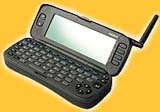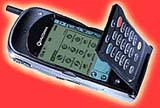These cell phones are smarter than you
By Hiawatha Bray, Globe Staff, 07/29/99



SMART PHONES: The Nokia phone/mini-PC, the QualComm/Palmpilot combo, and the StarTac/Franklin Rex pairing (top to bottom) are changing how we think about cell phones.
(Globe Staff Photo (bottom) / Mark Wilson)
|
We've come to expect that cellular phones would keep getting smaller. And some of them will.
But others are getting bigger and heavier, as designers cram them with advanced features that might almost make you forget to phone home.
Now that half of us have computers at home and the Internet is part of our way of life, it's not enough for cell phones to just be phones.
People need ''smart phones'' capable of exchanging data with their desktop machines and even communicating over the Internet.
At least, this is what the phone makers think. So they're churning out a lot of high-powered hardware that could give your briefcase a higher IQ than your brain.
One of the smartest and biggest portable phones comes from the Finnish firm Nokia (www.nokia.com). Their 9000IL Communicator is a cell phone that wants to be a laptop.
The telephonic face of the device flips open to reveal a cramped but serviceable keyboard and a small black-and-white liquid crystal screen. From here you can keep track of your appointments, type notes, and send faxes.
And as you'd expect, the Communicator has address book software that links up nicely with the cell phone. Just look up the name of someone you need to call, press a button, and the Communicator gives that person a ring.
The Communicator also boasts full-service Internet access - or as full service as you can get with a slow, wireless modem. If you already have an account with an Internet service provider, you can peck your way through a rather gnarly set-up procedure, and wind up with a device that will collect your e-mail, send replies, and even do a bit of Web surfing.
You wouldn't want to spend much time browsing on the Communicator, with its small monochrome screen and tiny keyboard. But the device has its uses.
It works well enough to let you download news headlines, for instance. Or you could pop over to the MapQuest Web site and get driving directions to your next appointment.
Of course, by the time you download them, using a modem with a top speed of 13,200 bits per second, it'd probably be easier to find out by calling instead.
All this comes in a package that weighs about a pound. Carry this in your suit jacket and you'll be walking sideways. Then again, the reduced weight of your wallet may compensate - the 9000IL goes for around $700, with cellular activation.
But tuck the Communicator in a briefcase or purse, and you've got an acceptable laptop substitute for light-duty road trips.
Soon, you'll be able to get your hands on a device that does much the same stuff as the Nokia Communicator, but which will fit a little more comfortably in a pocket.
That's because cell phone maker Qualcomm (www.qualcomm.com) has teamed up with 3Com (www.3com.com), maker of the popular Palm Pilot electronic organizers. The result is the PDQ, a phone with a built-in Palm Pilot.
Judging by a prototype we've seen, the PDQ is a sleeker, lighter alternative to the Nokia phone. It's been cleverly designed with a thin phone keypad that flips down to reveal a standard Palm Pilot device.
Qualcomm's PDQ will have a strong advantage over rival products when it comes to market. There are more than 3 million Palm Pilot users who are already comfortable with that pen-operated device, so a PDQ will feel like coming home.
In addition, there are lots of auxiliary software programs designed especially for Palm devices, as well as Web sites that have created special content for the new Palm VII wireless Web surfing device. All this stuff will work with the PDQ as well.
Still, the PDQ can't match the crowd-pleasing proportions and light weight of a Palm Pilot. Just having to include a hefty battery to power both cell phone and Palm device turns the PDQ into a brick. A small, light, rather pretty brick, to be sure, but not the easiest device to tote.
The engineers at Motorola (www.motorola.com) opted for a different approach - less brains, but also less strain.
Like Qualcomm, they decided to add an existing pocket computer to one of their phones. But Motorola picked the smallest, simplest device of its kind - Franklin Electronics's Rex (www.franklin.com) pocket organizer.
The Rex is far less sophisticated than a Palm. You can't enter text by writing on the screen with a pen, or download new software. All the Rex will do is store your address book, appointments, and other such housekeeping data. Attach the Rex to a computer, upload the data into it, and slip it into your shirt pocket.
Motorola bought Starfish Software (www.starfish.com), the firm that made the underlying software for the Rex. But then they got really clever. Instead of designing a new kind of cell phone with a Rex built in, they designed a clip-on device that lets you attach a new version of the Rex to one of Motorola's ultra-small StarTAC flip phones.
It's called the StarTAC Clip-On Organizer and it sells for $250, not including phone. A StarTAC phone will run around $300 or so with activation.
It won't surf the Internet or check your e-mail, but it will dial any phone number in the Rex address book at the touch of a button. It has limited data entry features that let you add more names, numbers, or appointments.
And the Clip-On Organizer lets you keep all this important data right where it will do the most good - clipped to the side of a phone so small you could lose it in a well-stuffed purse.
Even with the Clip-On attached, the Motorola weighs only about 6 ounces - by far the lightest of this trio. Which might make it the smartest cell phone of all.
Hiawatha Bray writes about technology for the Globe. His column, Upgrade, runs every Thursday in the Business section. His e-mail address is [email protected].


